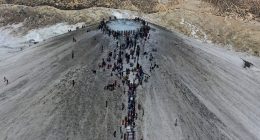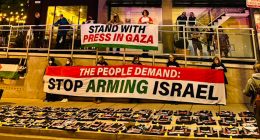
Even before embarking on her first documentary, Cow, director Andrea Arnold incorporated certain nonfiction elements into her scripted films. There were the naturalistic shots of animals, insects and nature interspersed through 2009’s Fish Tank, her 2011 adaptation of Wuthering Heights and 2016’s American Honey, the nonactors and unknowns that have populated so many of her films (launching the careers of Sasha Lane and Katie Jarvis) and the kitchen-sink realism of their settings, from Fish Tank‘s public housing complex to American Honey‘s road trip through the rural U.S.
But Cow, which releases in theaters and on-demand on Friday, takes this approach to a new level. The star of the film is Luma, an English dairy cow whose life consists of giving birth, getting milked, being inseminated, experiencing veterinary checkups and, occasionally, going out into an open field to graze. Her calves are separated from her early, destined to grow up in a different part of the same farm than their mothers, who are living out “this maternal cycle for all of their lives,” says Arnold. The film takes an intimate look at Luma’s life, often presenting her at eye level, using many shots from her point of view, threading music played at the farm into the film’s soundtrack and only showing farmers insofar as they are working with Luma, her calf or other cows in the farm; there is no narration.
“I just thought, why don’t I try and see if I can film an animal a bit like I film my characters, so just focusing on one consciousness and one being?” Arnold says. Perhaps unsurprisingly, editing the film was a challenge: “I had to find something that felt like a shape, and that felt quite tricky,” she says.
Cow is a long time in the making: Arnold says the project first took shape about nine years ago, and the film subsequently took four years to make. In an interview with The Hollywood Reporter, the director discusses her process for finding the star of the film, the challenges involved in her first foray into the documentary space and why she’s going to keep striving for theatrical, instead of streaming, releases.
How did this film get started for you?
It’s a long story where it came from, actually, but it came out of a feeling of disconnect with nature. I was sort of thinking, why do I feel so disconnected and how can I connect? How could I turn the camera toward something that might make people also connect? And then I just thought, why don’t I try and see if I can film an animal a bit like I film my characters, so just focusing on one consciousness and one being? I thought that might be quite interesting because we might really get to know them and we might really get to see their personality and that might be a good thing.
What was the process like for choosing the particular cow that you wanted to follow? Did you have any audition process?
We had to find a farm, and we had to find a farm that was within striking distance of London because we had to go regularly and also last-minute, and that took a little while. Then, once we found the farm, we had to identify a cow. We were looking for a cow that was pregnant because I wanted to start with a birth, so there were only so many cows that were pregnant. And I asked [the farmers] about their personalities and they mentioned Luma at the very beginning, I think, and they said she was feisty — like she’s a feisty cow. I thought that was good: It obviously meant that she has some character. And then also when I met her, she’s got this very beautiful white head with the eyeliner. At the beginning, I wasn’t sure that you [would] always be able to pick her out in a crowd, but I thought with that head we had more chance of seeing her. But in actual fact I think I needn’t have worried because I think any cow I focused on, you would have got to know them. She did have a very beautiful head anyway, and I thought she was beautiful. So we picked Luma.
How did funding come together on this film compared to other films of yours? Was it difficult to find folks who were willing to back this?
Actually, I was very lucky because one of the first people we asked for money was Christine Langan, who was at the BBC then. Christine had actually grown up with cows, so when I talked to her about it, she completely got it, so I think I was just lucky that she had had a relationship with cows. I’m not sure there would have been many people at the beginning [otherwise]. And even since then, people say, “Oh, what are you doing?” And I say, “I’ve been doing this and this and this. And I’m making a film about a cow.” And they go, “What’s it about?” And I go, “Well, it’s about a cow.” I never knew how to describe it. I could just talk about where it came from and my passion for it; there wasn’t going to be a story or drama or whatever. So it was quite a simple idea. There’s always a lot of love for [cows], anyone who’s had any sort of relationship or connection with them. They talk about them very lovingly, so I think Christine was [one of those people], obviously. I didn’t even know that about her, but thank god.
You mentioned you wanted to start this film with a birth. To what extent did you plan production out in advance, and to what extent did you stay around the farm and film spontaneous moments?
A dairy cow’s life is very busy: It’s about giving milk, it’s about getting pregnant and it’s about giving birth and then giving milk. They live this maternal cycle for all of their lives, so there’s a lot of things involved in that: There’s a lot of vet visits; there’s insemination, there’s the bull; when they’re pregnant, there’s all the scans and the things they have to have done; and then the birth and then there’s the milking. So there’s a cycle and there’s lots of things going on all the time. So we would go for all of those days, and then I would just go do filming on a regular day, where they’re just coming in for milking. So we would do regular days and also the days where they have special things going on.
When it comes to camerawork, oftentimes the camera is placed at the height of the cows and the camera gets quite close to them, to the point where a few times a cow hits the camera. What was that filming experience like and did the cows have to get used to the camera at all?
I think they’re used to people being around — there’s a lot of farmhands and farmers around all the time. And they’re very used to very early on having humans around, from birth. So I don’t think they were too affected by us being there. But I always made the point of saying, if she [Luma] reacts to the camera, if she doesn’t like it or she responds, then we’ll include that. I didn’t want to pretend that we were not there because we were there, and her reaction to us was part of the truth of it, so that’s why I included some of those things. I mean, you could easily cut those things out and not have them so that you don’t realize the camera’s there, but to me, the camera being there was part of it. So I was very clear to make that part of it. Occasionally, if she got in a mood about something that was going on, she would butt a camera or something, like “Get out of my way, I don’t like it.” And I would think, well, that’s fair enough. I respect all of that; I was respectful of her annoyance with us sometimes.
Let’s talk a little bit about the music that is in the film. Did you insert any music at all or did all of the songs come straight from what the farm itself was playing?
The farm had a pop radio on in the cowshed, which is playing lots of love songs, the way pop radio does. And I thought, oh, that’s so interesting, because pop music is about love and longing and desire and wanting and can’t have and I miss you and where are you. I thought that’s so interesting because that’s kind of what’s going on here a little bit, because of all the separations of the cows and the calves. There is a lot of longing in that cowshed you feel. So the music felt like a gift. Most of it, not all of it, comes from the farmers. Some of it comes from the farm and some of it I put in, but as an extension [of the existing music]. Because I can’t just clear anything I like, that’s not possible. As most filmmakers know, the music thing is tough, and also money for some things. But I basically used that as a lifting-off point, the music that’s there. I used the reality and kind of just grew that a little bit.
Given that this is your first feature documentary, what were the particular challenges that you found in making a nonfiction film and what were the elements that were similar to your previous films?
I guess the challenge of this, and I think it probably was a challenge, is because we had so much footage, and in a way, how do you make a narrative of that? How do you put together a kind of beginning, middle and end? A lot of events are quite same-y, in a way. The good thing: We weren’t really in a rush to finish it, so we would edit a bit, and then there would be a gap, and then obviously we had lockdown and stuff, so there would be gaps, and I would look at everything and basically try to use my intuition and picked out anything that felt important. But there was no clear story, exactly, and I had to find something. I guess that’s true of a lot of documentaries because there was no narrative at all, on some level. I had to find something that felt like a shape, and that felt quite tricky. But then I’m always playing with editing, like when I worked on American Honey and I worked with Joe Bini, I’m always trying to find different ways to work that might bring about some interesting creativity. And I said to Joe, “What about if we sit through the dailies and we talk about them and then you don’t look at the script?” And that’s what we did.
I’m always, I think, incorporating into my drama documentary elements to try and bring about life. I’ve always got a lot of real kids, always using real locations. If there’s something happening in the background, I think, “Oh great, let’s include that.” I sort of love it to be a little chaotic, and if it’s not chaotic enough, I’ll introduce something that brings a bit of chaos. I think when you’re first at film school, there’s this idea that you make storyboards and everything’s going to be exactly like this — I really don’t like that. I like the idea that I’m surprised and that the day surprises me and whoever we’ve cast surprises me. So I think I’ve always slightly had documentary elements in the fiction as well so that it’s all sort of overlapping.
Was there ever a conversation about selling this to a streaming service, given the popularity of documentary on those platforms right now?
I’ve always believed in cinema. I still do. I know that streaming is part of the world right now, and filmmakers want their films seen. But I do really believe in cinema, I believe in that collective experience, I believe in the power of the big image. And I believe in the space it gives an audience to have their own experience with what’s happening. I believe in having people in a room all together, I believe in them not answering the door to delivery in the middle of the film or making a cup of coffee. You get people in a room for a short amount of time and you give them an experience. It’s like an invitation by the filmmaker to go “I’m going to give you an experience in this dark room altogether, here you are.” It’s a very different thing sitting at home by yourself and fast-forwarding. So I believe there’s always going to be a bunch of people that want that [theatrical experience], and I still very much believe in that. Obviously, streaming’s become a big part of life and that’s how a lot of films are getting seen, but I will still strive to make cinema and get it seen at the cinema. I’m going to keep on with that.
Are you planning on making more documentaries now that you’ve made this one?
I think I will. I have some thoughts, but they’re all beginning thoughts. They’re all quite not conventional ideas.
What are you working on next?
I’ve written something that I’ve been writing for a little while and that I’m hoping to do next. It’s fiction, so it’s more of my fiction stuff. But I was hoping to make that this year.
Interview edited for length and clarity.
Source: Hollywood




